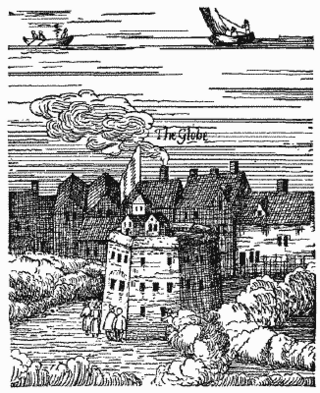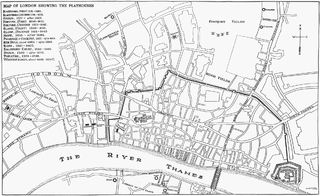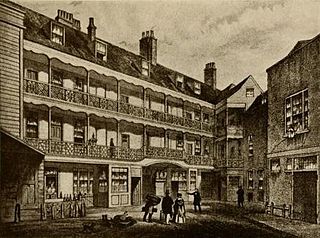Related Research Articles

The Globe Theatre was a theatre in London associated with William Shakespeare. It was built in 1599 at Southwark, close to the south bank of the Thames, by Shakespeare's playing company, the Lord Chamberlain's Men. It was destroyed by fire on 29 June 1613. A second Globe Theatre was built on the same site by June 1614 and stayed open until the London theatre closures of 1642. As well as plays by Shakespeare, early works by Ben Jonson, Thomas Dekker and John Fletcher were first performed here.
John Webster was an English Jacobean dramatist best known for his tragedies The White Devil and The Duchess of Malfi, which are often seen as masterpieces of the early 17th-century English stage. His life and career overlapped with Shakespeare's.

Thomas Dekker was an English Elizabethan dramatist and pamphleteer, a versatile and prolific writer, whose career spanned several decades and brought him into contact with many of the period's most famous dramatists.
Philip Henslowe was an Elizabethan theatrical entrepreneur and impresario. Henslowe's modern reputation rests on the survival of his diary, a primary source for information about the theatrical world of Renaissance London.

The Rose was an Elizabethan theatre. It was the fourth of the public theatres to be built, after The Theatre (1576), the Curtain (1577), and the theatre at Newington Butts – and the first of several playhouses to be situated in Bankside, Southwark, in a liberty outside the jurisdiction of the City of London's civic authorities. Its remains were excavated by archaeologists in 1989 and are listed by Historic England as a Scheduled Monument.
Anthony Munday was an English playwright and miscellaneous writer. He was baptized on 13 October 1560 in St Gregory by St Paul's, London, and was the son of Christopher Munday, a stationer, and Jane Munday. He was one of the chief predecessors of Shakespeare in English dramatic composition, and wrote plays about Robin Hood. He is believed to be the primary author of Sir Thomas More, on which he is believed to have collaborated with Henry Chettle, Thomas Heywood, William Shakespeare, and Thomas Dekker.

The Theatre was an Elizabethan playhouse in Shoreditch, just outside the City of London. Built in 1576, after the Red Lion, it was the first permanent theatre built exclusively for the showing of theatrical productions in England, and its first successful one. Actor-manager James Burbage built it near the family home in Holywell Street. The Theatre's history includes a number of important acting troupes including the Lord Chamberlain's Men, which employed Shakespeare as actor and playwright. After a dispute with the landlord, the theatre was dismantled and the timbers used in the construction of the Globe Theatre on Bankside.

John Marston was an English playwright, poet and satirist during the late Elizabethan and early Jacobean periods. His career as a writer lasted only a decade. His work is remembered for its energetic and often obscure style, its contributions to the development of a distinctively Jacobean style in poetry, and its idiosyncratic vocabulary.
City comedy, also known as citizen comedy, is a genre of comedy in the English early modern theatre.
The Lord Chamberlain's Men was a company of actors, or a "playing company", for which William Shakespeare wrote during most of his career. Richard Burbage played most of the lead roles, including Hamlet, Othello, King Lear, and Macbeth. Formed at the end of a period of flux in the theatrical world of London, it had become, by 1603, one of the two leading companies of the city and was subsequently patronized by James I.

The Red Bull was an inn-yard conversion erected in Clerkenwell, London, operating in the 17th century. For more than four decades, it entertained audiences drawn primarily from the City and its suburbs, developing a reputation over the years for rowdiness. After Parliament closed the theatres in 1642, it continued to host illegal performances intermittently, and when the theatres reopened after the Restoration, it became a legitimate venue again. There is a myth that it burned down in the Great Fire of London but the direct reason for its end is unclear.
Christopher Beeston was a successful actor and a powerful theatrical impresario in early 17th century London. He was associated with a number of playwrights, particularly Thomas Heywood.
Francis Langley (1548–1602) was a theatre builder and theatrical producer in Elizabethan era London. After James Burbage and Philip Henslowe, Langley was the third significant entrepreneurial figure active at the height of the development of English Renaissance theatre.

In the historical era of English Renaissance drama, an Inn-yard theatre or Inn-theatre was a common inn with an inner courtyard with balconies that provided a venue for the presentation of stage plays.

The Boar's Head Inn is the name of several former and current taverns in London, most famously a tavern in Eastcheap that is supposedly the meeting place of Sir John Falstaff, Prince Hal and other characters in Shakespeare's Henry IV plays. An earlier tavern in Southwark used the same name, and an inn of the name in Whitechapel was used as a theatre.
Susan Shore Browne Greene Baskervile, or Baskerville, was one of the most influential and significant women involved in English Renaissance theatre, as theatre investor, litigant, and wife, widow, and mother of actors.
Robert Browne was an English actor of the Elizabethan era, and the owner and manager of the Boar's Head Theatre. He is also part of an enduring confusion in the study of English Renaissance theatre.
Robert Browne was an English actor and theatre manager and investor of the later sixteenth and early seventeenth centuries. He was also part of a long-standing confusion in the scholarship of English Renaissance theatre.
John Brayne was a member of the Worshipful Company of Grocers. He built the Red Lion playhouse, and financed, with his brother-in-law, James Burbage, the building of the Theatre in Shoreditch, in which he was to have had a half interest. He also leased the George Inn in Whitechapel with a friend, Robert Miles. The latter two ventures, particularly the financing of the Theatre, bankrupted him, and he fell out with both James Burbage and Robert Miles. It was suspected that his death in 1586 was caused by blows received during an altercation with Miles. His widow, Margaret, backed financially by Miles, was involved in litigation with Burbage over Brayne's half interest in the Theatre until her own death in 1593.
References
- Berry, Herbert; C. Walter Hodges, illus. (1986). The Boar's Head Playhouse. Washington: Folger Shakespeare Library Press.
- Leggatt, Alexander (1992). Jacobean Public Theatre. London: Routledge.
- Sisson, Charles Jasper. (1972). The Boar's Head Theatre: an inn-yard theatre of the Elizabethan age. London: Routledge.